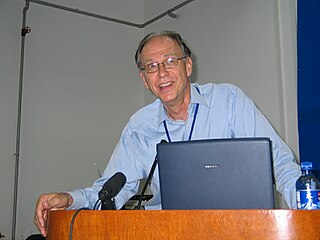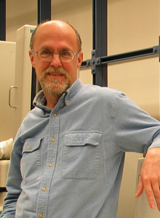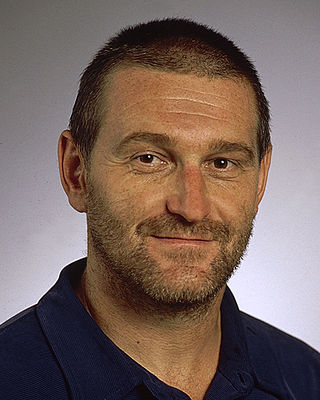Related Research Articles

In algorithmic information theory, the Kolmogorov complexity of an object, such as a piece of text, is the length of a shortest computer program that produces the object as output. It is a measure of the computational resources needed to specify the object, and is also known as algorithmic complexity, Solomonoff–Kolmogorov–Chaitin complexity, program-size complexity, descriptive complexity, or algorithmic entropy. It is named after Andrey Kolmogorov, who first published on the subject in 1963 and is a generalization of classical information theory.

Gregory John Chaitin is an Argentine-American mathematician and computer scientist. Beginning in the late 1960s, Chaitin made contributions to algorithmic information theory and metamathematics, in particular a computer-theoretic result equivalent to Gödel's incompleteness theorem. He is considered to be one of the founders of what is today known as algorithmic complexity together with Andrei Kolmogorov and Ray Solomonoff. Along with the works of e.g. Solomonoff, Kolmogorov, Martin-Löf, and Leonid Levin, algorithmic information theory became a foundational part of theoretical computer science, information theory, and mathematical logic. It is a common subject in several computer science curricula. Besides computer scientists, Chaitin's work draws attention of many philosophers and mathematicians to fundamental problems in mathematical creativity and digital philosophy.
Ray Solomonoff was an American mathematician who invented algorithmic probability, his General Theory of Inductive Inference, and was a founder of algorithmic information theory. He was an originator of the branch of artificial intelligence based on machine learning, prediction and probability. He circulated the first report on non-semantic machine learning in 1956.

In algorithmic information theory, algorithmic probability, also known as Solomonoff probability, is a mathematical method of assigning a prior probability to a given observation. It was invented by Ray Solomonoff in the 1960s. It is used in inductive inference theory and analyses of algorithms. In his general theory of inductive inference, Solomonoff uses the method together with Bayes' rule to obtain probabilities of prediction for an algorithm's future outputs.
Low-complexity art, first described by Jürgen Schmidhuber in 1997 and now established as a seminal topic within the larger field of computer science, is art that can be described by a short computer program.
Solomonoff's theory of inductive inference is a mathematical theory of induction introduced by Ray Solomonoff, based on probability theory and theoretical computer science. In essence, Solomonoff's induction derives the posterior probability of any computable theory, given a sequence of observed data. This posterior probability is derived from Bayes' rule and some universal prior, that is, a prior that assigns a positive probability to any computable theory.
Algorithmic information theory (AIT) is a branch of theoretical computer science that concerns itself with the relationship between computation and information of computably generated objects (as opposed to stochastically generated), such as strings or any other data structure. In other words, it is shown within algorithmic information theory that computational incompressibility "mimics" (except for a constant that only depends on the chosen universal programming language) the relations or inequalities found in information theory. According to Gregory Chaitin, it is "the result of putting Shannon's information theory and Turing's computability theory into a cocktail shaker and shaking vigorously."

Michael Spencer Waterman is a Professor of Biology, Mathematics and Computer Science at the University of Southern California (USC), where he holds an Endowed Associates Chair in Biological Sciences, Mathematics and Computer Science. He previously held positions at Los Alamos National Laboratory and Idaho State University.

Webb Colby Miller is an American bioinformatician who is professor in the Department of Biology and the Department of Computer Science and Engineering at The Pennsylvania State University.

Søren Brunak is a Danish biological and physical scientist working in bioinformatics, systems biology, and medical informatics. He is a professor of Disease Systems Biology at the University of Copenhagen and professor of bioinformatics at the Technical University of Denmark. As Research Director at the Novo Nordisk Foundation Center for Protein Research at the University of Copenhagen Medical School, he leads a research effort where molecular-level systems biology data are combined with phenotypic data from the healthcare sector, such as electronic patient records, registry information, and biobank questionnaires. A major aim is to understand the network biology basis for time-ordered comorbidities and discriminate between treatment-related disease correlations and other comorbidities in disease trajectories. Søren Brunak also holds a position as a Medical Informatics Officer at Rigshospitalet, the Capital Region of Denmark.
Mark Borodovsky is a Regents' Professor at the Join Wallace H. Coulter Department of Biomedical Engineering of Georgia Institute of Technology and Emory University and Director of the Center for Bioinformatics and Computational Genomics at Georgia Tech. He has also been a Chair of the Department of Bioinformatics at the Moscow Institute of Physics and Technology in Moscow, Russia from 2012 to 2022.

Paul Michael Béla Vitányi is a Dutch computer scientist, Professor of Computer Science at the University of Amsterdam and researcher at the Dutch Centrum Wiskunde & Informatica.

Pavel Arkadevich Pevzner is the Ronald R. Taylor Professor of Computer Science and director of the NIH Center for Computational Mass Spectrometry at University of California, San Diego. He serves on the editorial board of PLoS Computational Biology and he is a member of the Genome Institute of Singapore scientific advisory board.
In bioinformatics, alignment-free sequence analysis approaches to molecular sequence and structure data provide alternatives over alignment-based approaches.

Ron Shamir is an Israeli professor of computer science known for his work in graph theory and in computational biology. He holds the Raymond and Beverly Sackler Chair in Bioinformatics, and is the founder and former head of the Edmond J. Safra Center for Bioinformatics at Tel Aviv University.

Bonnie Anne Berger is an American mathematician and computer scientist, who works as the Simons professor of mathematics and professor of electrical engineering and computer science at the Massachusetts Institute of Technology. She is the head of the Computation and Biology group at MIT's Computer Science and Artificial Intelligence Laboratory. Her research interests are in algorithms, bioinformatics and computational molecular biology.
Daniel Mier Gusfield is an American computer scientist, Distinguished Professor of Computer Science at the University of California, Davis. Gusfield is known for his research in combinatorial optimization and computational biology.
Mona Singh is a Professor of Computer Science in the Lewis-Sigler Institute for Integrative Genomics at Princeton University.
Péter Gács, professionally also known as Peter Gacs, is a Hungarian-American mathematician and computer scientist, professor, and an external member of the Hungarian Academy of Sciences. He is well known for his work in reliable computation, randomness in computing, algorithmic complexity, algorithmic probability, and information theory.
Tao Jiang is a Chinese-Canadian computer scientist and bioinformatician. He is Distinguished Professor of Computer Science and Engineering at the University of California, Riverside and was previously Distinguished Visiting Professor at Tsinghua University and Professor of Computer Science at McMaster University.
References
- ↑ M. Li and P. Vitanyi, Inductive reasoning and Kolmogorov complexity. Journal of Computer and System Sciences, (special issue for Structure’89) 44:2(1992), 343-384.
- ↑ "Profile of Ming Li". 8 February 2017.
- ↑ Ming Li at the Mathematics Genealogy Project
- ↑ M. Li, P. M. B. Vitányi, "Applications of Algorithmic Information Theory", Scholarpedia, 2(5):2658; 2007
- ↑ M. Li and P. M. B.Vitányi, An Introduction to Kolmogorov Complexity and its Applications, Springer, New York, 1993 (1st Ed.), 1997 (2nd ed.), 2008 (3rd ed.)
- ↑ "Ask computer a question, computer answers". The Record. 8 July 2015. Retrieved 28 October 2016.
- ↑ "Government of Canada announces talented and diverse group of new and renewed Canada Research Chairs". 28 June 2016.
- ↑ "Award Recipients – FCCP".
- ↑ "Archived copy" (PDF). Archived from the original (PDF) on 2017-03-13. Retrieved 2018-08-15.
{{cite web}}: CS1 maint: archived copy as title (link) - ↑ "Canada Research Chairs". 29 November 2012.
- 1 2 https://uwaterloo.ca/math50/international-honours-and-awards [ dead link ]
- ↑ "Fellows | the Royal Society of Canada".
- ↑ "Ontario Newsroom".
- ↑ "March 02, 2021: ISCB Congratulates and Introduces the 2021 Class of Fellows!". www.iscb.org. Retrieved 17 June 2022.